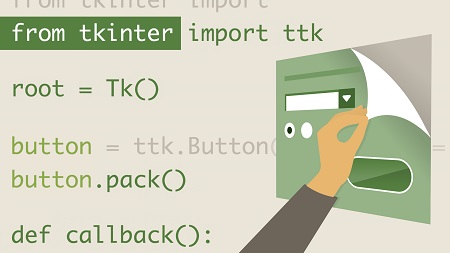
English | MP4 | AVC 1280×720 | AAC 48KHz 2ch | 4h 55m | 694 MB
Put an end to writing command-line interfaces for your programs. Use Tkinter, the Python package for creating themed interface elements with the Tk GUI toolkit. Join Barron Stone in this course as he walks through the most popular Tk widgets and shows you how to customize their appearance and behavior to fit your application. Learn how to manage the placement of those widgets on the GUI and make them react to user behavior with event-driven code. The final chapter takes you through the entire start-to-finish process of building the user interface for an application, so you can see how all of these techniques work in a real-world development scenario.
Topics include:
- Installing Python 3 and Tcl/Tk for Mac or Windows
- Creating and configuring themed Tk widgets
- Decorating the GUI with text labels and images
- Capturing input from buttons, menus, and entry fields
- Presenting choices with check boxes and radio buttons
- Using geometry managers to lay out the GUI
- Organizing widgets inside of frames and windows
- Handling user actions with event-driven programming
- Creating a simple drawing tool with the Canvas
- Prompting users with pop-up dialog boxes
Table of Contents
Introduction
1 Create a GUI for your Python desktop application
2 What you should know
3 Using the exercise files
Getting Started with Python and Tkinter
4 Installing Python 3 and Tcl Tk for Windows
5 Installing Python 3 and Tcl Tk for Mac
6 Saying hello to Tkinter
Tkinter Concepts
7 Tk and Tkinter background
8 Creating and configuring widgets
9 Managing widget placement
10 Handling user events
11 Revisiting Hello Tkinter
Basic Widgets
12 Displaying text and images with labels
13 Capturing input with buttons
14 Presenting choices with check buttons and radio buttons
15 Entering single-line text with the Entry widget
16 Making selections with the Combobox and Spinbox
17 Inputting values and displaying status with the Scale and Progressbar
Organizational Widgets
18 Organizing widgets with frames
19 Creating additional top-level windows
20 Separating widgets within paned windows
21 Grouping widgeting within a tabbed notebook
Advanced Widgets
22 Entering and displaying multiple lines with the Text widget
23 Adding tags marks images and widgets to the Text widget
24 Building a hierarchical treeview
25 Adding columns and selecting items in the Treeview
26 Building cascading menus
27 Drawing a basic line on the Canvas
28 Drawing complex shapes on the Canvas
29 Attaching a scroll bar to widgets
30 Configuring widget styles
31 Prompting users with the Messagebox and dialogs
Geometry Management
32 Using the Pack geometry manager
33 Using the Grid geometry manager
34 Using the Place geometry manager
Event Handling
35 Configuring command callbacks
36 Binding to keyboard events
37 Binding to mouse events
38 Binding to virtual events
39 Binding to multiple events
Building an Application
40 Defining project requirements
41 Planning the design
42 Creating the widgets
43 Laying out of the widgets
44 Binding to events
45 Finishing the GUI with style
Conclusion
46 Next steps
Resolve the captcha to access the links!